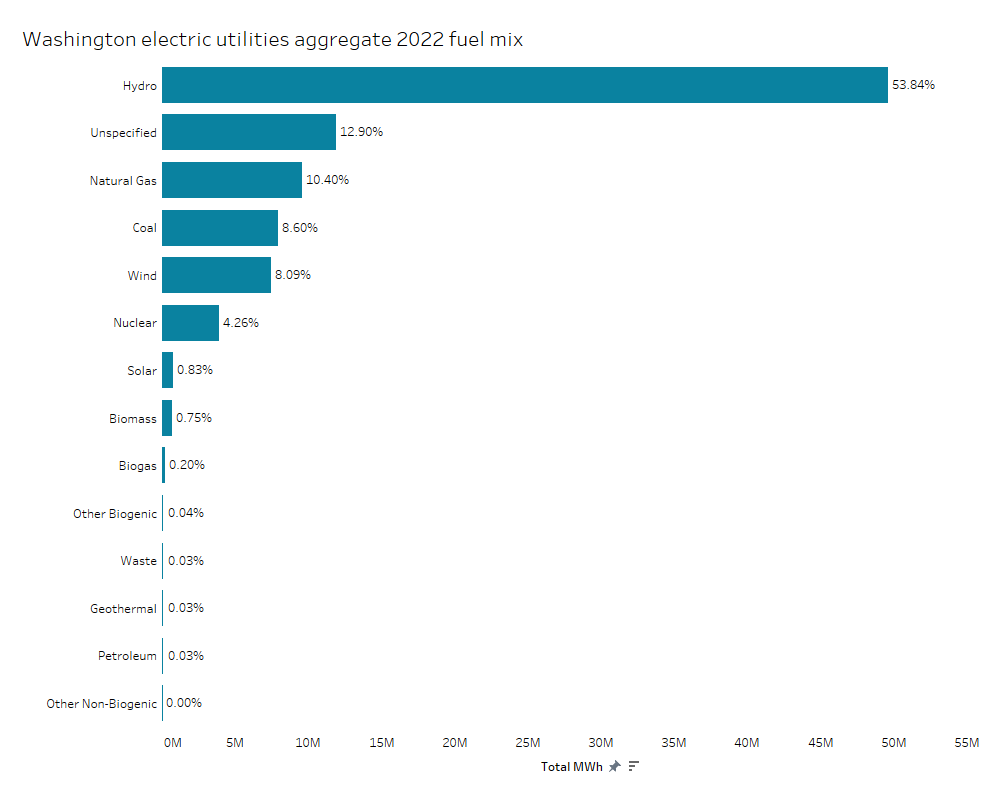Fuel Mix Disclosure and Greenhouse Gas Content Reports

Annual Fuel Mix Reports
- 2022 Disclosure Data (pdf)
- 2021 Disclosure Data (pdf)
- 2020 Disclosure Data (pdf)
- 2019 Disclosure Data (pdf)
- 2018 Disclosure Data (pdf)
- 2017 Disclosure Data (pdf)
- 2016 Disclosure Data (pdf)
- 2015 Disclosure Data (pdf)
- 2014 Disclosure Data (pdf)
- 2013 Disclosure Data (pdf)
- 2012 Disclosure Data (pdf)
- 2011 Disclosure Data (pdf)
- 2010 Disclosure Data (pdf)
- 2009 Disclosure Data (pdf)
- 2008 Disclosure Data (pdf)
- 2007 Disclosure Data (pdf)
Each electric supplier, or utility, serving retail customers in Washington must disclose to its customers the mix of fuels used to generate the electricity sold to those customers in the previous year. Utilities must disclose the information, similar to a content label on a food product, to new customers and post the information on their public websites. The disclosure must show the percentage of electricity by fuel type, such as coal, hydroelectricity, natural gas, nuclear, wind, and solar. If the utility does not know the source of some electricity, it must label that portion as “unspecified source.”
The Department of Commerce fuel mix program supports disclosure by ensuring consistent reporting. More than 60 utilities submit information to Commerce about specific generating resources that the utility uses to serve Washington customers. The Bonneville Power Administration provides the same information for the electricity that it delivers to utilities in Washington. Commerce compiles the individual reports, checks the information in comparison to published data on power plant generation, and summarizes it in a statewide fuel mix estimate.
Commerce also uses the fuel mix reports to estimate the statewide greenhouse gas emissions from electricity consumed in Washington. The Department of Ecology uses this information as an input for the overall greenhouse gas inventory for the state.
Starting in 2021, each utility must calculate and report the greenhouse gas content of the electricity it provides to retail customers in Washington. This calculation must be based on the amounts and fuel sources claimed in the fuel mix disclosure program. Emissions must be calculated using a methodology established by the Department of Ecology. Utilities are not required to post or publish these results, but Commerce will publish the information on this page.
Utility Data
Utilities provide the following information to Commerce in megawatt-hours (MWh):
- Total electricity retail sales including power purchases necessary to cover line losses.
- Amounts of specified sources acquired by contract or ownership, by generating resource and fuel.
- Amounts of market or unspecified power used to serve retail load.
- Amount of electricity purchased from BPA.
2024 Fuel Mix Disclosure Reporting Period
TBD
Electric Utility Greenhouse Gas Content Reporting
During the 2024 legislative session, the Legislature passed
and Governor Inslee signed House
Bill 1955 which repealed the greenhouse gas content calculation requirement
in the Clean Energy Transformation Act. However, utilities are required to
comply with the law for the years it was on the books. Commerce revised the
reporting process for those years (2020-2022) to help utilities comply with the
law. Commerce utilized the fuel mix disclosure to estimate the greenhouse gas
content of electricity for each utility for calendar years 2020-2022, and
Commerce received confirmations and adjustments from utilities on the
greenhouse gas content estimates.
Additional Resources
Need help?
Aaron Tam
Data Specialist
energydata@commerce.wa.gov
Phone: 360-764-9632
